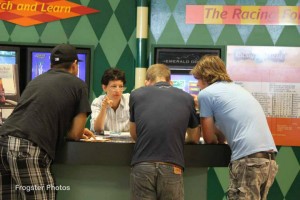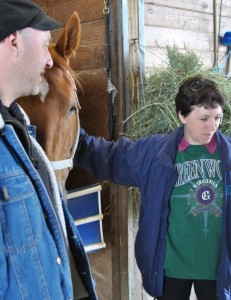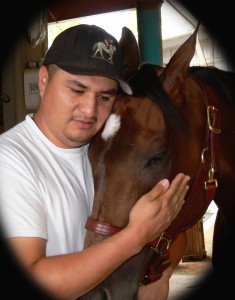Long before Lezlie Wolff became what she calls a “Thoroughbred liaison” —writing articles for an industry magazine and helping to attract a new crop of race fans through the Emerald Downs New Comer’s Center—Ms. Wolff was mucking stalls at a Washington racecourse.
The up-close perspective provided by that job at Longacres Racecourse, combined with her family background as racehorse owners, helped get Wolff moving toward a career in that world and a calling to raise awareness on behalf of the Thoroughbred.
In this week’s Clubhouse Q&A, Wolff talks about her work to attract new fans to the game, and to push for better advocacy for our beloved equine athletes.
Q: Please tell me about the work you do for Washington Thoroughbred, and who was your favorite equine athlete to be featured in your many profiles?
The Washington Thoroughbred magazine is a publication of the Washington Thoroughbred Breeders and Owners Association (WTBOA). I have the privilege to write profiles on horses and people involved in Washington State horseracing. Last year I profiled the speedy little mare, You Me and Ema B, and her wonderful staff including trainer Margo Lloyd, jockey Debbie Hoonan, Ema’s personal assistant Alex Rodriguez and her gallop rider, Byron Rodriguez. I am proud to say I am a friend of Ema’s.
I also help the WTBOA during our summer sale running contracts to buyers for their signatures after they’ve bid on and purchased a yearling.
In addition, the WTBOA and Emerald Downs host a yearly equine art show which I’ve submitted my photos to in the last two years. We get breathtaking entrees from around the world. This is just one of the many unique things you’ll come across in our Pacific Northwest corner of the industry.
I bring up the sale and the art show because my awesome editor at the magazine, M. Anne Sweet, is also my boss at the sale and the co-curator for the art show. We all wear a lot of hats here!
Q: What is your background with Thoroughbreds and how did you get into the field?
I call myself the Thoroughbred Liaison. In all that I do, I endeavor through actions, words and pictures, to put voice to the horse/human connection.
I started mucking stalls at Longacres Racecourse, Renton, Wash., when I was in high school, either 1975 or 76. My parents had a special cheap claiming horse, Lucky Seas, who was an exciting closer. He ran into his 9th year and I was his groom for much of his career. I like to say I gave my soul to the Thoroughbred species at that time and they have made all my dreams come true since.
My first professional writing gig was for the North County News in Bedford, N.Y. writing a monthly horse column for the weekly paper. One of my editors there had been a writer for the Daily Racing Form and he was wonderful to work with.
This summer is the first time I’ve worked officially on the front side. At Emerald Downs in Auburn, Wash., my main responsibility is in Fan Education at our New Comer’s Center. I empower people who are new to racing on how to enjoy themselves. I teach them how to read and comprehend the Racing Form and program, how to develop wagering strategies, plus where all the awesome food and beverage options are, as well as the many entertainments. It’s very rewarding work.
Q: Where does the sport of Thoroughbred racing stand today? How can it attract new and younger fans?
This is an interesting question because at Emerald Downs we have a young crowd and it’s a Crowd! I suggest that all tracks take note of what we are doing at Emerald Downs as I believe we are establishing marketing strategies that would benefit the entire industry.
My work in the New Comer’s Center gives me the opportunity to speak directly to those people our marketing department is attracting. Our attendance is up with young people. These people tell me they were brought to Emerald Downs as children and now they are bringing their children. We make our track a unique sports and entertainment event destination. We are committed to fan friendliness and exceptional customer service.
That being said, I think North American Thoroughbred horseracing needs a total paradigm shift. We are in a new era of human experience where we are seeing the traditions of previous eras going extinct daily. If we are to not just survive, but to thrive, our industry needs to evolve.
The three major changes, which I think are of greatest import are:
First, make the welfare of the Thoroughbred our number one priority. Because of their tremendous generosity and prodigious hearts, Thoroughbreds bear the burden of our lives and livelihoods. Let’s follow Cavalia’s lead and make the well being of these extraordinary individuals our paramount priority. By doing this, we can counter any naysayer who attempts to inhibit our occupation. By doing this, I believe each and all of our lives we will significantly benefit.
Next, we need to establish a means by which the backside horsemen (the heart) and the front side management (the head) can participate in safe, open and productive dialogue through which both can learn to work together as one body. There are organizations who can mentor us in this undertaking such as The Compassionate Listening Project who does similar work between Israelis and Palestinians.
Finally, we need innovative marketing strategies to attract new interests in our industry. Let’s troll in the seas of the technologically to attract sophisticated new fans. Groups of these people come to me daily at my New Comer’s post. They’re smart, fun and are prime for participating in syndicates. The market is out there, we need to grab it!
Q: How does all the awareness of Thoroughbred welfare fit into the racing world?
I think a Thoroughbred Advocacy Organization, exclusive to the well being of the horse, would be a big part of the response. As I said before, I believe that the industry’s mission should make the wellbeing of the horse its number one objective. This mission needs to trickle down to every participating component of racing from the track owners, management and workers to the broadcasters and writers and further, on to the trainers, horse owners and horse-care providers all the way to all the service and product suppliers.
The recent coverage on the ills of racing has actually been good for us. It has brought our weaknesses into the daylight, and offers us the opportunity address them. For example, let’s work on, and come to agreement on, regulation, industry standards, and best practices. I think addressing these issues with regard to making the welfare of the horse the number one objective, will serve our industry well.
The other best thing we can do is to get the horses stories out! We DO love our horses and it’s a love like no other. With social media and writers, these stories are the key to transforming our industry. Let’s hear it from them, the horses, let’s broadcast their stories and get them the fans and acknowledgment they deserve!






Thanks, TBDancer!
What a great article about a thoughtful approach to aftercare for racehorses. Lezlie has been there, done most of it and has a unique perspective on racing, “both sides now” and all that.
I totally agree with Lezlie’s statement, “The recent coverage on the ills of racing has actually been good for us.”
Knowledge is power and if the “ills of racing” remain the sport’s “dirty little secret,” nothing will change. I’ve seen changes in the past six years that have created more opportunities for more horses. We just have to make certain the number of “retirees in second careers” increases.